key PORSCHE 911 2014 6.G Information Manual
[x] Cancel search | Manufacturer: PORSCHE, Model Year: 2014, Model line: 911, Model: PORSCHE 911 2014 6.GPages: 75, PDF Size: 11.41 MB
Page 10 of 75

1819
S
trength
| The 911 Carrera
Meetings, conferences, business lunches.
How about some leisure in between?
The 911 Carrera.
In the 21st century, we find ourselves
caught bet ween all kinds of opposites on
a daily basis: bet ween the demands of
our work life and our private life, between
the real world and virtual realit y. How can
they all be reconciled? With a strong iden -
tit y and a sports car that has incorporated
many contradictory notions since 1963.
Sportiness and everyday practicality are
a prime example. The new 911 Carrera is
equipped as standard with direct fuel
injection
(DFI) and VarioCam Plus for high
power, high torque, efficient combustion
and, as a result, comparatively low fuel
consumption. Tradition and innovation blend seamlessly
together in the 3.4-litre, six-cylinder
horizontally opposed engine. The figures
speak for themselves. The maximum
power of 257 kW (350 hp) is available at
7,400 rpm and the maximum torque of
390 Nm is generated at 5,600 rpm. Even
more impressively, the car accelerates
from 0 to 100 km/ h in 4.8 seconds and
reaches a top speed of 289 km/ h.
The 911 Carrera generates powerful
forces, which are transmit ted precisely
and directly to the wheels by the 7-speed
manual gearbox. As with the optional PDK,
gears 1 to 6 have a sports ratio, while 7th gear has a long ratio for reduced fuel
consumption. The SPORT but ton, which
is fit ted as standard, makes it possible to
select an even more responsive engine
and transmission setup.
In terms of form and function, the single
tailpipes are especially imposing and
emit a sound that is t ypically Porsche.
The 19-inch Carrera wheels are fit ted as
standard and offer excellent driving
stability and performance.
Sports car technology as standard, in
the form of black four-piston aluminium
monobloc fixed calipers, Porsche
Stabilit y Management (PSM) and Bi-Xenon
headlights, shows that sportiness and
safet y are not mutually exclusive.
Sport, moderation, everyday practicality
and st yle. Four key themes, one unifying
concept: the 911 Carrera.
For fuel consumption, CO
2 emissions and efficiency class, please refer to pages 141/143.
Page 27 of 75
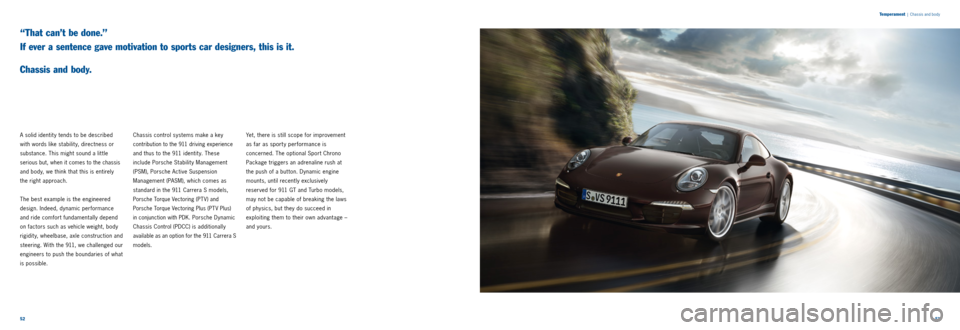
5253
T
emperament
| Chassis and body
“That can’t be done.”
If ever a sentence gave motivation to sports car designers, this is it.
Chassis and body.
A solid identit y tends to be described
with words like stability, directness or
substance. This might sound a lit tle
serious but, when it comes to the chassis
and body, we think that this is entirely
the right approach.
The best example is the engineered
design. Indeed, dynamic performance
and ride comfort fundamentally depend
on factors such as vehicle weight, body
rigidity, wheelbase, axle construction and
steering. With the 911, we challenged our
engineers to push the boundaries of what
is possible. Chassis control systems make a key
contribution to the 911 driving experience
and thus to the 911 identit y. These
include Porsche Stability Management
(PSM), Porsche Active Suspension
Management (PASM), which comes as
standard in the 911 Carrera S models,
Porsche Torque Vectoring (PT V) and
Porsche Torque Vectoring Plus (PT V Plus)
in conjunction with PDK. Porsche Dynamic
Chassis Control (PDCC) is additionally
available as an option for the 911 Carrera S
models.
Yet, there is still scope for improvement
as far as sport y performance is
concerned. The optional Sport Chrono
Package triggers an adrenaline rush at
the push of a but ton. Dynamic engine
mounts, until recently exclusively
reserved for 911
GT and Turbo models,
may not be capable of breaking the laws
of physics, but they do succeed in
exploiting them to their own advantage –
and yours.
Page 28 of 75
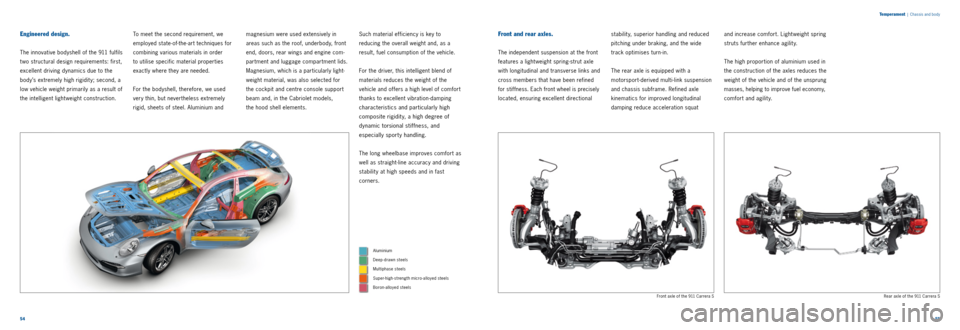
5455
T
emperament
| Chassis and body
Aluminium
Deep -drawn steels
Multiphase steels
Super- high -strength micro -alloyed steels
Boron- alloyed steels
Front and rear axles.
The independent suspension at the front
features a light weight spring-strut axle
with longitudinal and transverse links and
cross members that have been refined
for stiffness. Each front wheel is precisely
located, ensuring excellent directional stability, superior handling and reduced
pitching under braking, and the wide
track optimises turn-
in.
The rear axle is equipped with a
motorsport- derived multi -link suspension
and chassis subframe. Refined axle
kinematics for improved longitudinal
damping reduce acceleration squat and increase comfort. Light weight spring
struts further enhance agilit y.
The high proportion of aluminium used in
the construction of the axles reduces the
weight of the vehicle and of the unsprung masses, helping to improve fuel economy,
comfort and agility.
Rear axle of the 911 Carrera S
Front axle of the 911 Carrera S
Engineered design.
The innovative bodyshell of the 911 fulfils
t wo structural design requirements: first,
excellent driving dynamics due to the
body’s extremely high rigidit y; second, a
low vehicle weight primarily as a result of
the intelligent lightweight construction.
To meet the second requirement, we
employed state -of -the- art techniques for
combining various materials in order
to utilise specific material properties
exactly where they are needed.
For the bodyshell, therefore, we used
very thin, but nevertheless extremely
rigid, sheets of steel. Aluminium and magnesium were used extensively in
areas such as the roof, underbody, front
end, doors, rear wings and engine com
-
partment and luggage compartment lids.
Magnesium, which is a particularly light -
weight material, was also selected for
the cockpit and centre console support
beam and, in the Cabriolet models,
the hood shell elements. Such material efficiency is key to
reducing the overall weight and, as a
result, fuel consumption of the vehicle.
For the driver, this intelligent blend of
materials reduces the weight of the
vehicle and offers a high level of comfort
thanks to excellent vibration-damping
characteristics and particularly high
composite rigidit y, a high degree of
dynamic torsional stiffness, and
especially sporty handling.
The long wheelbase improves comfort as
well as straight-line accuracy and driving
stabilit y at high speeds and in fast
corners.
Page 29 of 75
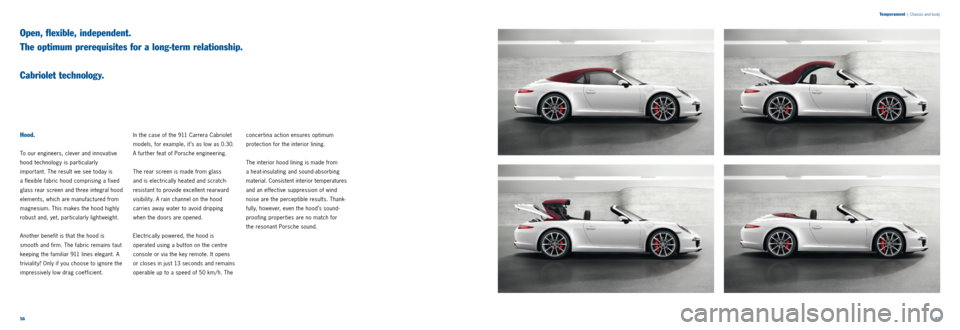
5657
T
emperament
| Chassis and body
Hood.
To our engineers, clever and innovative
hood technology is particularly
important. The result we see today is
a flexible fabric hood comprising a fixed
glass rear screen and three integral hood
elements, which are manufactured from
magnesium. This makes the hood highly
robust and, yet, particularly light weight.
Another benefit is that the hood is
smooth and firm. The fabric remains taut
keeping the familiar 911 lines elegant. A
trivialit y? Only if you choose to ignore the
impressively low drag coefficient. In the case of the 911 Carrera Cabriolet
models, for example, it ’s as low as 0.30.
A further feat of Porsche engineering.
The rear screen is made from glass
and is electrically heated and scratch-
resistant to provide excellent rearward
visibilit y. A rain channel on the hood
carries away water to avoid dripping
when the doors are opened.
Electrically powered, the hood is
operated using a but ton on the centre
console or via the key remote. It opens
or closes in just 13 seconds and remains
operable up to a speed of 50 km/ h. The concertina action ensures optimum
protection for the interior lining.
The interior hood lining is made from
a heat-
insulating and sound
-absorbing
material. Consistent interior temperatures
and an effective suppression of wind
noise are the perceptible results. Thank -
fully, however, even the hood’s sound -
proofing properties are no match for
the resonant Porsche sound.
Open, flexible, independent.
The optimum prerequisites for a long-term relationship.
Cabriolet technology.
Page 34 of 75
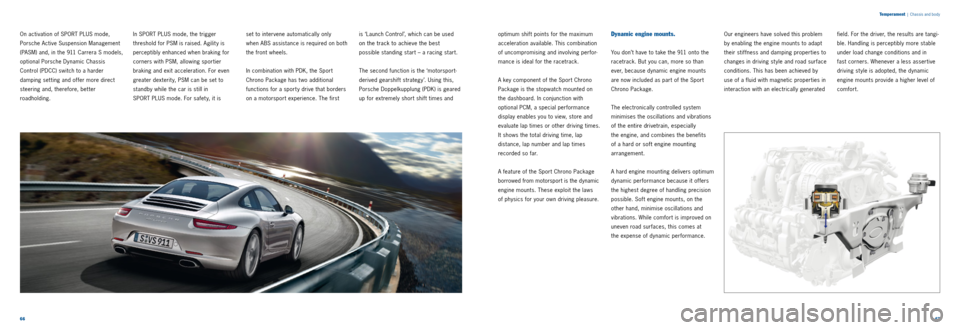
6667
T
emperament
| Chassis and body
On activation of SPORT PLUS mode,
Porsche Active Suspension Management
(PASM) and, in the 911 Carrera S models,
optional Porsche Dynamic Chassis
Control (PDCC) switch to a harder
damping set ting and offer more direct
steering and, therefore, better
roadholding. In SPORT PLUS mode, the trigger
threshold for PSM is raised. Agilit y is
perceptibly enhanced when braking for
corners with PSM, allowing sportier
braking and exit acceleration. For even
greater dexterit y, PSM can be set to
standby while the car is still in
SPORT PLUS mode. For safet y, it is
set to intervene automatically only
when ABS assistance is required on both
the front wheels.
In combination with PDK, the Sport
Chrono Package has t wo additional
functions for a sport y drive that borders
on a motorsport experience. The first is ‘Launch Control’, which can be used
on the track to achieve the best
possible standing start – a racing start.
The second function is the ‘motorsport-
derived gearshift strategy’. Using this,
Porsche Doppelkupplung (PDK) is geared
up for extremely short shift times and optimum shift points for the maximum
acceleration available. This combination
of uncompromising and involving perfor-
mance is ideal for the racetrack.
A key component of the Sport Chrono
Package is the stopwatch mounted on
the dashboard. In conjunction with
optional PCM, a special performance
display enables you to view, store and
evaluate lap times or other driving times.
It shows the total driving time, lap
distance, lap number and lap times
recorded so far.
A feature of the Sport Chrono Package
borrowed from motorsport is the dynamic
engine mounts. These exploit the laws
of physics for your own driving pleasure.
Dynamic engine mounts.
You don’t have to take the 911 onto the
racetrack. But you can, more so than
ever, because dynamic engine mounts
are now included as part of the Sport
Chrono Package.
The electronically controlled system
minimises the oscillations and vibrations
of the entire drivetrain, especially
the engine, and combines the benefits
of a hard or soft engine mounting
arrangement.
A hard engine mounting delivers optimum
dynamic performance because it offers
the highest degree of handling precision
possible. Soft engine mounts, on the
other hand, minimise oscillations and
vibrations. While comfort is improved on
uneven road surfaces, this comes at
the expense of dynamic performance. Our engineers have solved this problem
by enabling the engine mounts to adapt
their stiffness and damping properties to
changes in driving st yle and road surface
conditions. This has been achieved by
use of a fluid with magnetic properties in
interaction with an electrically generated
field. For the driver, the results are tangi-
ble. Handling is perceptibly more stable
under load change conditions and in
fast corners. Whenever a less assertive
driving st yle is adopted, the dynamic
engine mounts provide a higher level of
comfor t.
Page 39 of 75
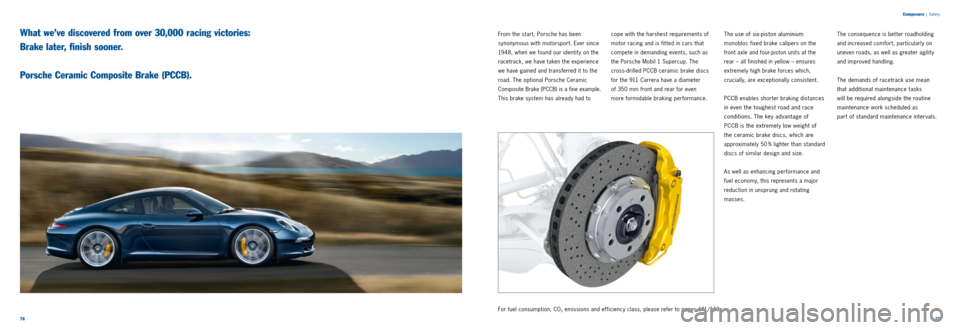
7677
From the start, Porsche has been
synonymous with motorsport. Ever since
1948, when we found our identit y on the
racetrack, we have taken the experience
we have gained and transferred it to the
road. The optional Porsche Ceramic
Composite Brake (PCCB) is a fine example.
This brake system has already had to
Composure | Safet y
cope with the harshest requirements of
motor racing and is fit ted in cars that
compete in demanding events, such as
the Porsche Mobil 1 Supercup. The
cross-drilled PCCB ceramic brake discs
for the 911 Carrera have a diameter
of 350 mm front and rear for even
more formidable braking performance. What we’ve discovered from over 30,000 racing victories:
Brake later, finish sooner.
Porsche Ceramic Composite Brake (PCCB).The use of six-piston aluminium
monobloc fixed brake calipers on the
front axle and four-piston units at the
rear – all finished in yellow – ensures
extremely high brake forces which,
crucially, are exceptionally consistent.
PCCB enables shorter braking distances
in even the toughest road and race
conditions. The key advantage of
PCCB is the extremely low weight of
the ceramic brake discs, which are
approximately 50 % lighter than standard
discs of similar design and size.
As well as enhancing performance and
fuel economy, this represents a major
reduction in unsprung and rotating
masses. The consequence is better roadholding
and increased comfort, particularly on
uneven roads, as well as greater agilit y
and improved handling.
The demands of racetrack use mean
that additional maintenance tasks
will be required alongside the routine
maintenance work scheduled as
part of standard maintenance intervals.
For fuel consumption, CO2 emissions and efficiency class, please refer to pages 141/143.
Page 46 of 75

9091
Composure
|
Comfort
Climate control.
The 911 models feature t wo -zone
automatic climate control as standard
with an enhanced ventilation effect and
separate temperature controls for the
driver and front passenger. The available
air conditioning modes are gentle,
normal and strong.
An active carbon filter traps particles,
pollen and odours and an automatic
air-recirculation function permanently
monitors air quality, reduces humidity
and switches from fresh to recirculated
air when required. A demister function
keeps the windows clear in cold weather. In warmer weather, a solar sensor helps
the climate control
to detect strong
sunlight and automatically
compensate
for the comfort of both the driver and
front passenger.
HomeLink® (programmable garage
door opener).
As an option, it is possible to have
a programmable garage door opener
integrated into the overhead console.
At the push of a but ton, it controls up
to three different garage doors, lighting
systems or alarm systems.
Many things have practical qualities.
Even more have a sporty function.
And some are just extremely convenient.
Additional comfort and convenience features.
Cruise control.
This automatic speed control function is
available as an option. For greater driver
comfort on long stretches of road, cruise
control operates in the 30 –240 km/ h
speed range and is activated using a but -
ton on the steering column control stalk.
Light design package.
The optional light design package is both
practical and aesthetically appealing.
It comprises dimmable LEDs in the over -
head console and in the areas of the
door pulls, door storage compartments,
front foot wells and rear seats.
‘Welcome Home’ lighting.
For convenience, particularly at night,
the ‘Welcome Home’ lighting function
automatically switches on the LED day -
time running lights for a defined period
whenever the vehicle is opened or
closed using the key remote.
A customisable delayed switch- off timer
keeps the day time running lights, the
taillights and, where applicable, the
courtesy lights switched on until you
reach your front door.
Adaptive cruise control with Porsche
Active Safe (PAS).
Available as an option, this cruise control
function regulates your speed according
to the distance bet ween your vehicle and
the vehicle in front. A radar sensor moni -
tors the road ahead up to a distance of
200 m. If you have set a cruising speed
but have begun to gain on the vehicle in front because it is driving more slowly,
this is detected by the radar sensor.
The system now reduces the speed
of your vehicle at a maximum rate of
3.5 m/sec
2 by restricting the throt tle
or by applying the brakes appropriate
to the prevailing situation until the dis -
tance that you have preset is maintained.
Your vehicle will now continue at a reduced speed. If the other vehicle
decelerates further, adaptive cruise
control will continue to reduce your
cruising speed – even down to a halt. For additional safet y, if the system detects
that the distance from the vehicle in front
is decreasing, it will also prepare your
vehicle for braking by precharging the
braking system so that the brake pads are already in light contact with the
brake discs. However, drivers still have
to perform heavier braking themselves.
As soon as the road ahead clears again,
your vehicle will accelerate back up to
the cruising speed originally set.
If your vehicle approaches the vehicle
in front too quickly, Porsche Active Safe
(PAS) will issue audible and visual warn
-
ings. In addition, the system briefly jerks
the brakes and if necessary initiates
target braking, with any braking pressure
applied by the driver being increased
within certain system limits.
Adaptive cruise control display
Radar sensor of adaptive cruise control
Page 48 of 75
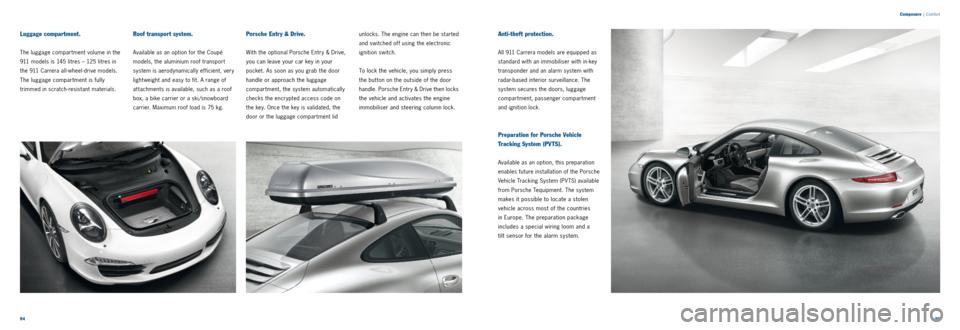
9495
Composure
|
Comfort
Porsche Entry & Drive.
With the optional Porsche Entry & Drive,
you can leave your car key in your
pocket. As soon as you grab the door
handle or approach the luggage
compartment, the system automatically
checks the encrypted access code on
the key. Once the key is validated, the
door or the luggage compartment lid unlocks. The engine can then be started
and switched off using the electronic
ignition switch.
To lock the vehicle, you simply press
the but ton on the outside of the door
handle. Porsche Entry & Drive then locks
the vehicle and activates the engine
immobiliser and steering column lock.
Luggage compartment.
The luggage compartment volume in the
911 models is 145 litres – 125 litres in
the 911 Carrera all-wheel- drive models.
The luggage compartment is fully
trimmed in scratch-resistant materials.
Roof transport system.
Available as an option for the Coupé
models, the aluminium roof transport
system is aerodynamically efficient, very
light weight and easy to fit. A range of
at tachments is available, such as a roof
box, a bike carrier or a ski/snowboard
carrier. Maximum roof load is 75 kg.
Anti-theft protection.
All 911 Carrera models are equipped as
standard with an immobiliser with in-key
transponder and an alarm system with
radar-based interior surveillance. The
system secures the doors, luggage
compartment, passenger compartment
and ignition lock.
Preparation for Porsche Vehicle
Tracking System (PVTS).
Available as an option, this preparation
enables future installation of the Porsche
Vehicle Tracking System (PV TS) available
from Porsche Tequipment. The system
makes it possible to locate a stolen
vehicle across most of the countries
in Europe. The preparation package
includes a special wiring loom and a
tilt sensor for the alarm system.
Page 50 of 75
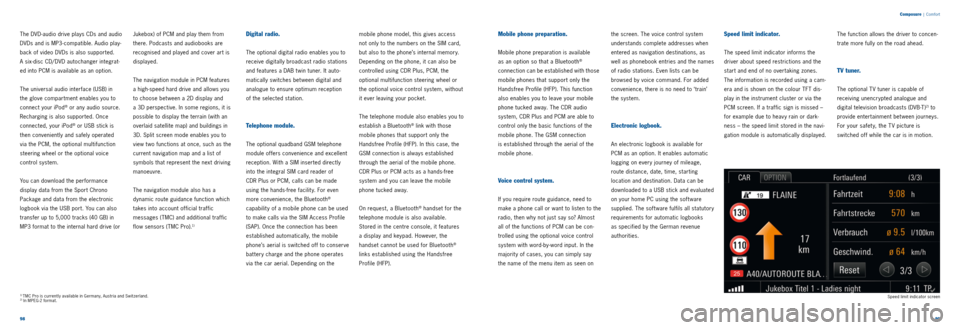
9899
Composure
|
Comfort
Digital radio.
The optional digital radio enables you to
receive digitally broadcast radio stations
and features a DAB t win tuner. It auto -
matically switches bet ween digital and
analogue to ensure optimum reception
of the selected station.
Telephone module.
The optional quadband GSM telephone
module offers convenience and excellent
reception. With a SIM inserted directly
into the integral SIM card reader of
CDR Plus or PCM, calls can be made
using the hands-free facilit y. For even
more convenience, the Bluetooth
®
capabilit y of a mobile phone can be used
to make calls via the SIM Access Profile
(SAP). Once the connection has been
established automatically, the mobile
phone’s aerial is switched off to conserve
battery charge and the phone operates
via the car aerial. Depending on the mobile phone model, this gives access
not only to the numbers on the SIM card,
but also to the phone’s internal memory.
Depending on the phone, it can also be
controlled using CDR Plus, PCM, the
optional multifunction steering wheel or
the optional voice control system, without
it ever leaving your pocket.
The telephone module also enables you to
establish a Bluetooth
® link with those
mobile phones that support only the
Handsfree Profile (HFP). In this case, the
GSM connection is always established
through the aerial of the mobile phone.
CDR Plus or PCM acts as a hands-free
system and you can leave the mobile
phone tucked away.
On request, a Bluetooth
® handset for the
telephone module is also available.
Stored in the centre console, it features
a display and keypad. However, the
handset cannot be used for Bluetooth
®
links established using the Handsfree
Profile (HFP).
Mobile phone preparation.
Mobile phone preparation is available
as an option so that a Bluetooth®
connection can be established with those
mobile phones that support only the
Handsfree Profile (HFP). This function
also enables you to leave your mobile
phone tucked away. The CDR audio
system, CDR Plus and PCM are able to
control only the basic functions of the
mobile phone. The GSM connection
is established through the aerial of the
mobile phone.
Voice control system.
If you require route guidance, need to
make a phone call or want to listen to the
radio, then why not just say so? Almost
all of the functions of PCM can be con -
trolled using the optional voice control
system with word -by
-word input. In the
majorit y of cases, you can simply say
the name of the menu item as seen on
1) TMC Pro is currently available in Germany, Austria and Switzerland.2) In MPEG -2 format.
The DVD-audio drive plays CDs and audio
DVDs and is MP3- compatible. Audio play -
back of video DVDs is also supported.
A six- disc CD/ DVD autochanger integrat -
ed into PCM is available as an option.
The universal audio interface (USB) in
the glove compartment enables you to
connect your iPod
® or any audio source.
Recharging is also supported. Once
connected, your iPod
® or USB stick is
then conveniently and safely operated
via the PCM, the optional multifunction
steering wheel or the optional voice
control system.
You can download the performance
display data from the Sport Chrono
Package and data from the electronic
logbook via the USB port. You can also
transfer up to 5,000 tracks (40 GB) in
MP3 format to the internal hard drive (or Jukebox) of PCM and play them from
there. Podcasts and audiobooks are
recognised and played and cover art is
displayed.
The navigation module in PCM features
a high-speed hard drive and allows you
to choose bet ween a 2D display and
a 3D perspective. In some regions, it is
possible to display the terrain (with an
overlaid satellite map) and buildings in
3D. Split screen mode enables you to
view t wo functions at once, such as the
current navigation map and a list of
symbols that represent the next driving
manoeuvre.
The navigation module also has a
dynamic route guidance function which
takes into account official traffic
messages (TMC) and additional traffic
flow sensors (TMC Pro).
1)
the screen. The voice control system
understands complete addresses when
entered as navigation destinations, as
well as phonebook entries and the names
of radio stations. Even lists can be
browsed by voice command. For added
convenience, there is no need to ‘train’
the system.
Electronic logbook.
An electronic logbook is available for
PCM as an option. It enables automatic
logging on every journey of mileage,
route distance, date, time, starting
location and destination. Data can be
downloaded to a USB stick and evaluated
on your home PC using the soft ware
supplied. The soft ware fulfils all statutory
requirements for automatic logbooks
as specified by the German revenue
authorities.
Speed limit indicator screen
Speed limit indicator.
The speed limit indicator informs the
driver about speed restrictions and the
start and end of no overtaking zones.
The information is recorded using a cam -
era and is shown on the colour TFT dis -
play in the instrument cluster or via the
PCM screen. If a traffic sign is missed –
for example due to heav y rain or dark -
ness – the speed limit stored in the navi -
gation module is automatically displayed. The function allows the driver to concen
-
trate more fully on the road ahead.
TV tuner.
The optional T V tuner is capable of
receiving unencrypted analogue and
digital television broadcasts (DVB-T)
2) to
provide entertainment between journeys.
For your safet y, the T V picture is
switched off while the car is in motion.